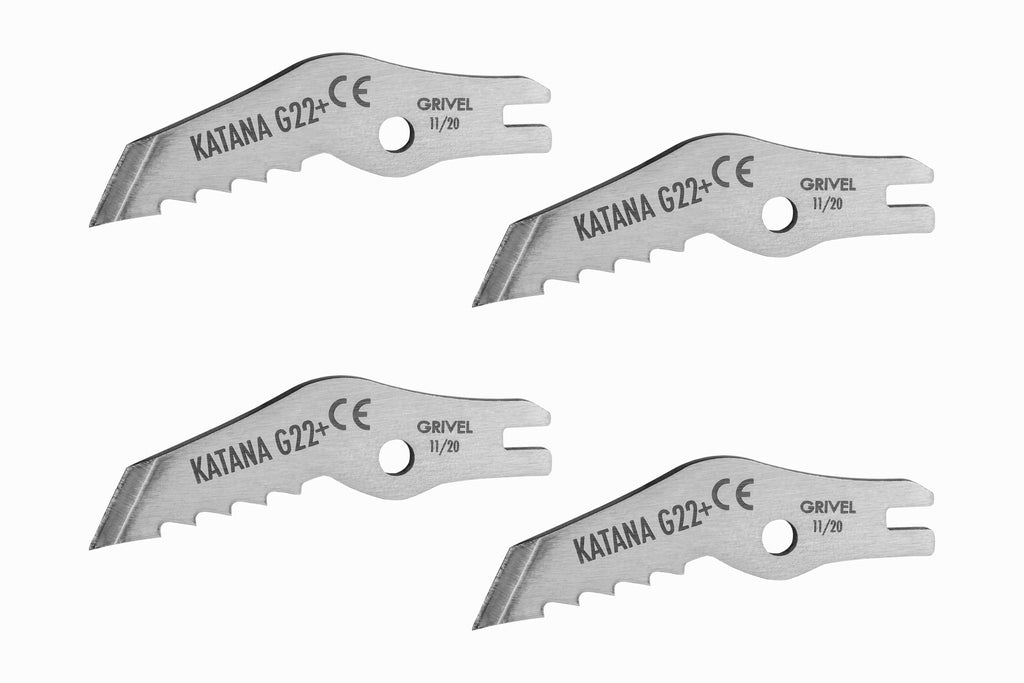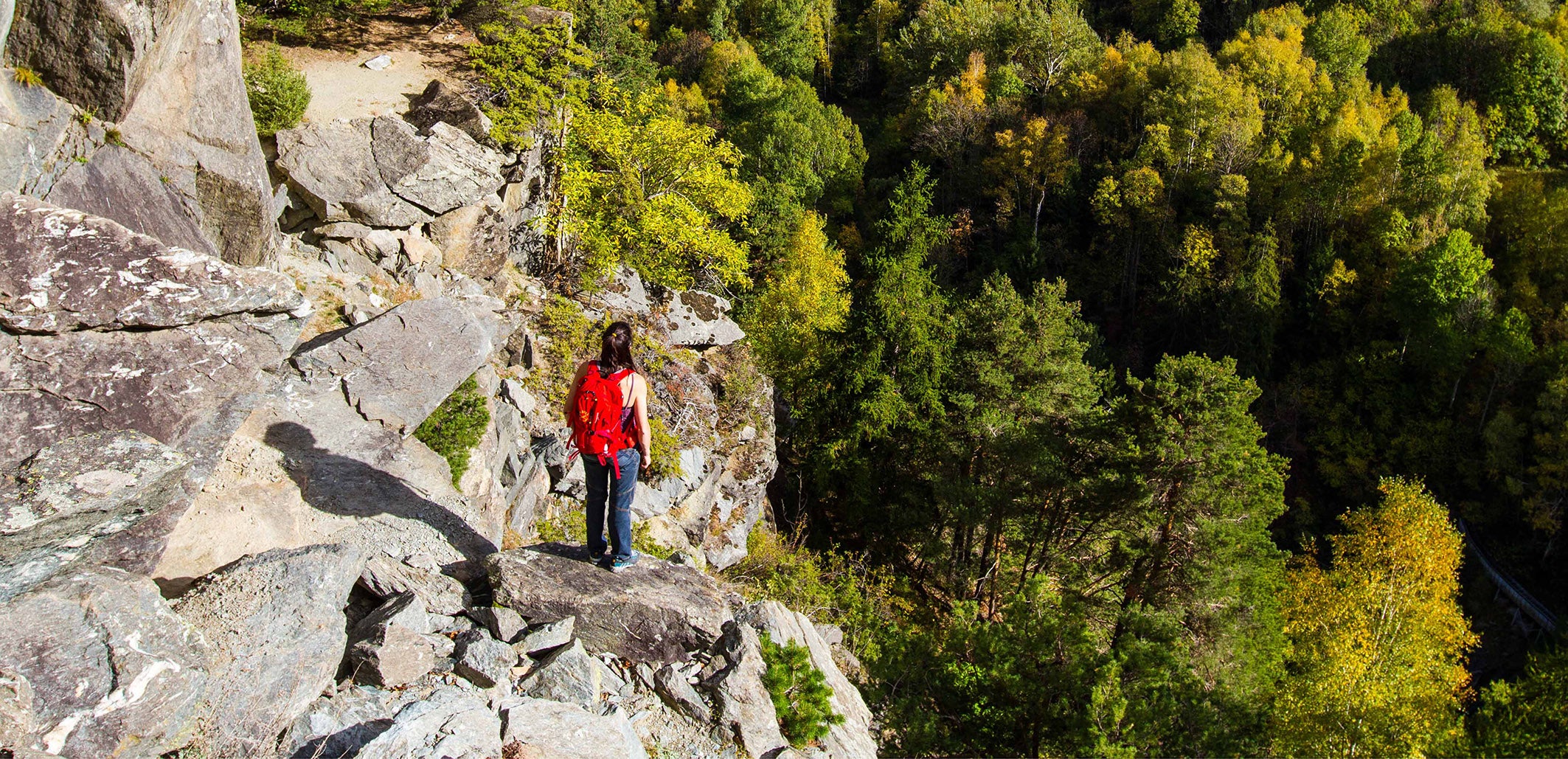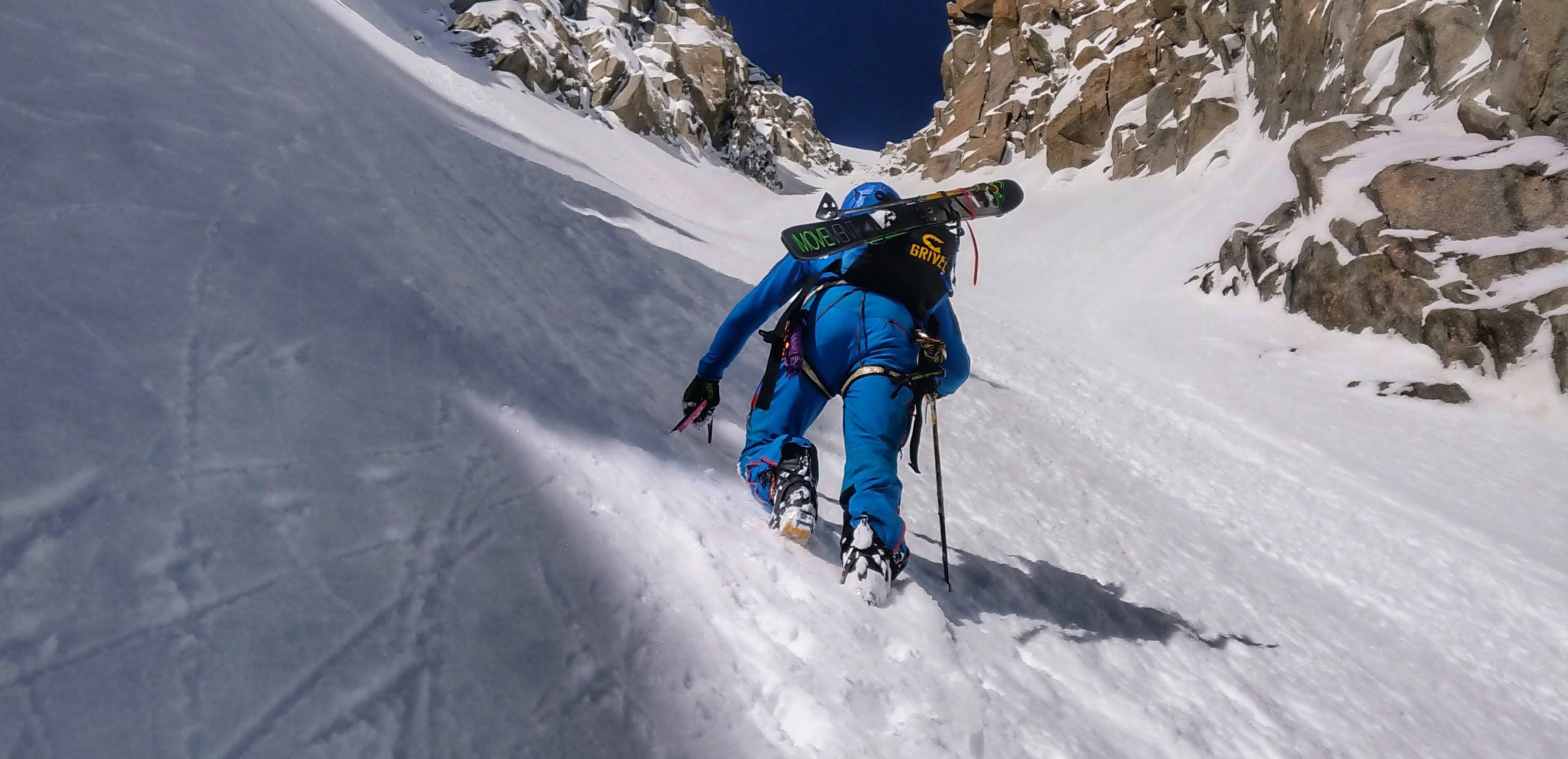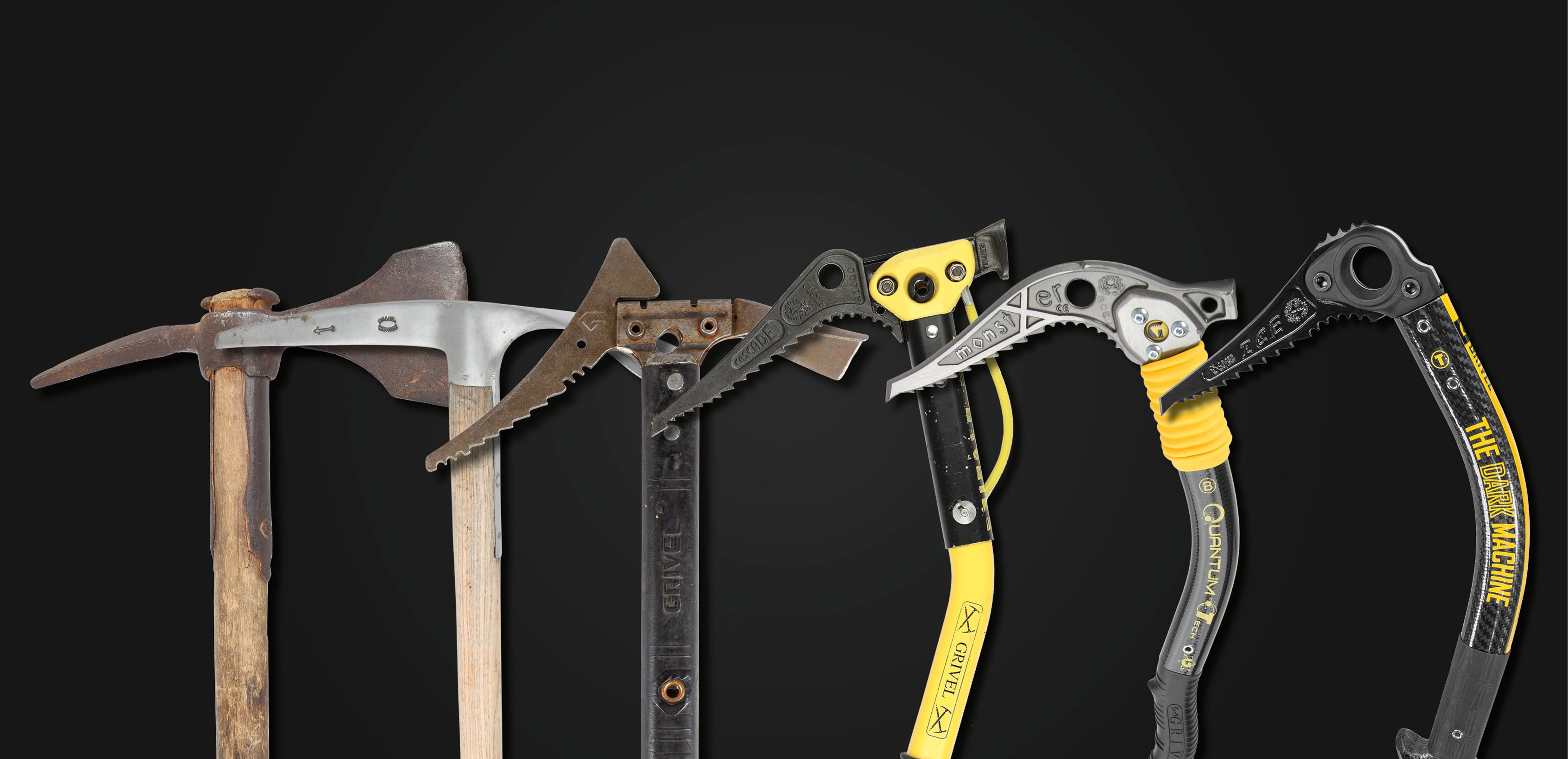
Ice Blades - History and Technology
Climbing on ice, with the help of a blade. Overcoming apparently invincible slopes, on what is ephemeral and aleatory by definition, on what was liquid, it was rain, it was the leap of a river, and then it will become liquid again. A hole in the water is synonymous with failure, but climbing a series of holes in the ice is one of the most adrenaline-pumping and aesthetic experiences you can have.
The progression with the blades is simple: you swing your ice axe in the ice, load the weight and proceed, step by step.
The history of the blades of ice axes starts a long time ago and Grivel has always followed and often anticipated their evolution.

In 1786 Balmat climbed to the top of Mont Blanc holding a long stick with a pointed tip and, fastened to his belt, a hatchet with a short handle; we therefore speak of sticks or alpenstocks, even very long ones to facilitate the descent and probe the snow.

A miniature halberd.

The ice axe was born around 1840 by combining these two components: the tool had to be especially suitable for cutting steps to make up for the lack of the technique of using crampons (which had not yet been invented!).


The first blades were almost straight, without teeth: the latter appeared only later with two or three notches only in the tip area.

Ice axes were mainly a tool to be used as a support stick and precisely to cut steps where to place the feet.

The modern ice axe was born with crampons.

Only in the early years of the twentieth century, with the widespread use of crampons (the first ones were made by Grivel in 1909), did the ice axe take on a more "modern" shape: the pick lengthens, about twice the size of the blade, and the handle begins to shorten, from 2/3 of the person's height to about half of the height; the first teeth appear on the tip to improve anchoring skills.


The transformation.
In 1938, the German Andreas Heckmair used a shorter ice axe with a very inclined blade, handcrafted to win the north face of the Eiger.

In the mid-1950s, the Austrian mountaineer Kurt Diemberger introduced the "ice dagger", which planted at shoulder height made it possible to remove and replant the ice axe higher without losing balance: you could speak for the first time of a second tool for progression.
The ice axes change face: the pick is made with a greater inclination and with a greater number of teeth, in some cases also on the upper side of the blade. This guarantees a firmer anchoring, but complicates the subsequent extraction of the tool.



The piolet Traction revolution.

Starting from the early 1970s, the new way of climbing on ice with two tools was established, called "piolet traction": a technique used for the first ascent of the North Couloir of the Dru (1973) by Walter Cecchinel and Claude Jager, ascent which in the Alps is identified as the first with this technique.


The radical transformation then occurs when the downward inclination of the blade is changed to facilitate traction, but complicating penetration into the ice.
At the same time, the lengths of the shafts were shortened: using the tools only in traction, they compromised the possibility of planting them above the head on slopes that quickly approached 90 degrees.
From Scotland, the Terrordactyl.
In the same years, however, we must record that Scottish mountaineers were already technically advanced, also given the terrain on which they climbed with walls with thin ice and cracks clogged with ice: more than a real ice axe, a sort of "hook" was needed to fit into the cracks and hook onto the rock holds: hence the birth of the first ice ax similar to the current ones called Terrordactyl designed and used by Mc Innes.

Very short shaft and super solid blade but also very short with 4 teeth on the tip, very inclined (over 45 degrees), but with a straight shape that worked well for hooks, but was very difficult to swing given the angle of insertion, with bad consequences even for the fingers banging against the wall. And it had a weight of over 800 grams!
The birth of the "banana".
In 1975, the idea of reversing the curvature of the tip was born, in America with Forrest, in France with Simond. The “Chacal” came to life, with the reverse curved blade called “banana”, a shape which is still used today. The banana shape greatly helps penetration into the ice and at the same time allows excellent traction.

The Chacal blade had a complete set of teeth up to the shaft, but it also had some limitations: the first was its length, greater than Terrodactyl, but still too short to protect the climber's fingers, the second that the curvature was minimal and it was difficult to swing it in the ice and, once it was in, it was very difficult to extract it, the third that the thickness of the blade was too high and the material with which it was made was rather fragile, breaking frequently especially if used in torsion.
At the beginning of the 1980s, modular tools (Simond, Grivel, Stubai, Lowe) became popular, better said with replaceable blades and hammers / shovels.

The Grivel Blades come into play.
In the early 1980s, Grivel took a step forward in this evolution with the Super Courmayeur, a system of interchangeable blades and accessories on the shafts. The system also includes the first forged, banana-shaped, interchangeable blade.

The forging process makes it possible to make thinner blades that break the ice less and enter more easily. They are less fragile and for the first time the curve of the banana is pushed to facilitate insertion and the blade is also lengthened by a few centimeters. Special care was also reserved for ease of extraction by increasing the curvature of the upper part of the blade and increasing the upper sharpening. Belays were often made on ice axes (screws were almost always the weak link in the system), which is why Grivel invented a blade with a very high top so that it can be hammered deeply using the hammer to create a secure anchor point.

Between the end of the 80s and the 90s, ice climbing evolved very rapidly, as did the equipment. The shafts begin to curve (but this is another story ...) and the blades have to respond to increasingly difficult technical requirements, for increasingly demanding climbs.

In the early 90s the blades were mostly flat or only with a slight central excavation, slightly longer than the reference Chacal, with homogeneous teeth (half-moons) which already represented the best compromise between holding and extraction.
Specialisation: to their own blade.
In 1993 Grivel began to differentiate and specialize blades according to their use.
The Evolution was truly an "extreme" ice blade with a very elongated banana shape that was also called "proboscis", very low at the tip and very thin in the tip area for optimal penetration without breaking the ice. The tip was very low and very inclined, while the very short teeth at the tip gradually increased in height.

The Face Nord blade was instead more all-round, shorter and thicker with less aggressive teeth and therefore more suitable for "heavy" use for mountain climbs (e.g. north faces, mixed climbs).

The search for lightness.
In those years, however, the idea of the maximum lightness of the tools began to spread, to save fatigue on the arms, so all excess masses are eliminated by reducing the ice axes and blades to the bare minimum. The blades are hollowed out inside, assuming a “double T” profile that allows for further lightening without compromising strength.
In 1995, the Evolution blade was further excavated and lightened, in the meantime a new intermediate Goulottes blade was presented, thinner than the North Face, but shorter and higher than the Evolution. The latter remained the top, of a truly unique design, characterized by a clear change of curvature in the tip area to facilitate the insertion as much as possible: this point also became the critical point of the peck and often the blade bent (without breaking however) and could be straightened back.


Shortly afterwards, the tubular blade was added, with the aim of breaking the ice less, and which worked well especially on porous ice. An idea initially promoted by the Americans, mostly Lowe, and also transferred to the Alps: while almost all companies made straight tubular blades (obtained from a tube) Grivel proposed a forged tubular blade on a banana shape!

In 1997, the revolutionary "The Machine" ice axe was introduced, with two new blades: the Cascade and the Mixte, which replaced the previous ones.

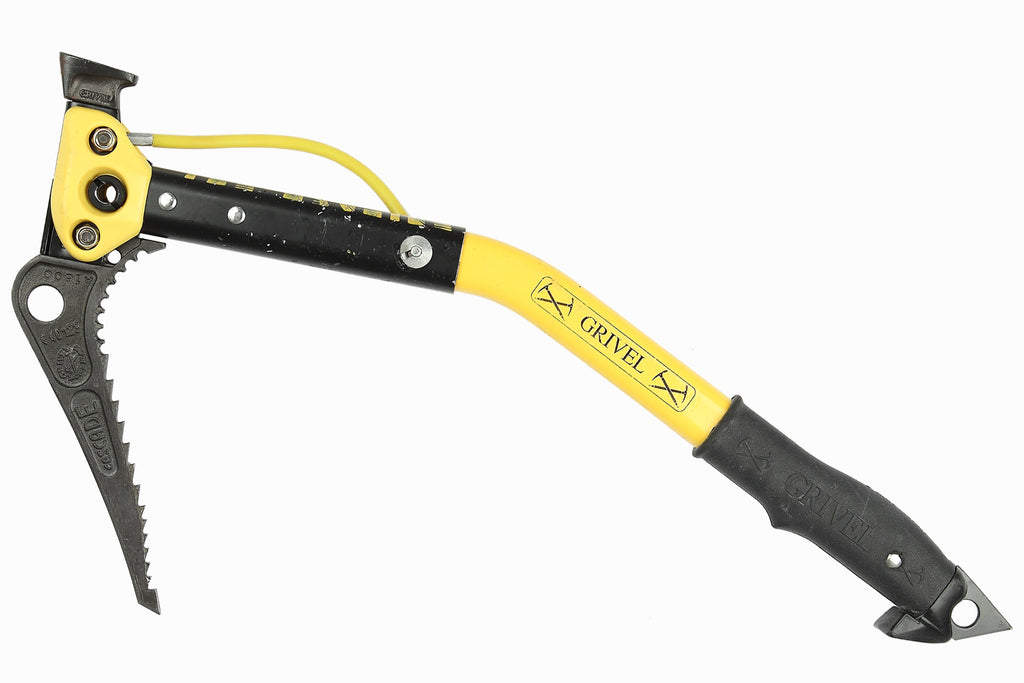

The first one is a less extreme Evolution, higher at the tip, less bent and with softer teeth, the second a far thicker and heavier blade that also ends in the upper part with a wedge zone to facilitate the use in the cracks. A blade to be used on mixed routes but not performing well on ice.
A choice of super-specialization also dictated by the rapid development of the modern mix that was beginning in those years. Indoor training was also started with ice axes on artificial holds and, to avoid damaging them, in 2000 Grivel presented a plastic-coated Indoor blade:

later, the structures were differentiated and a plastic blade was no longer necessary. Pushed by ice climbing competitions, very pointed blades have been made to hook into the holds and create a better hook. This is how the real dry tooling and competition blades were born.
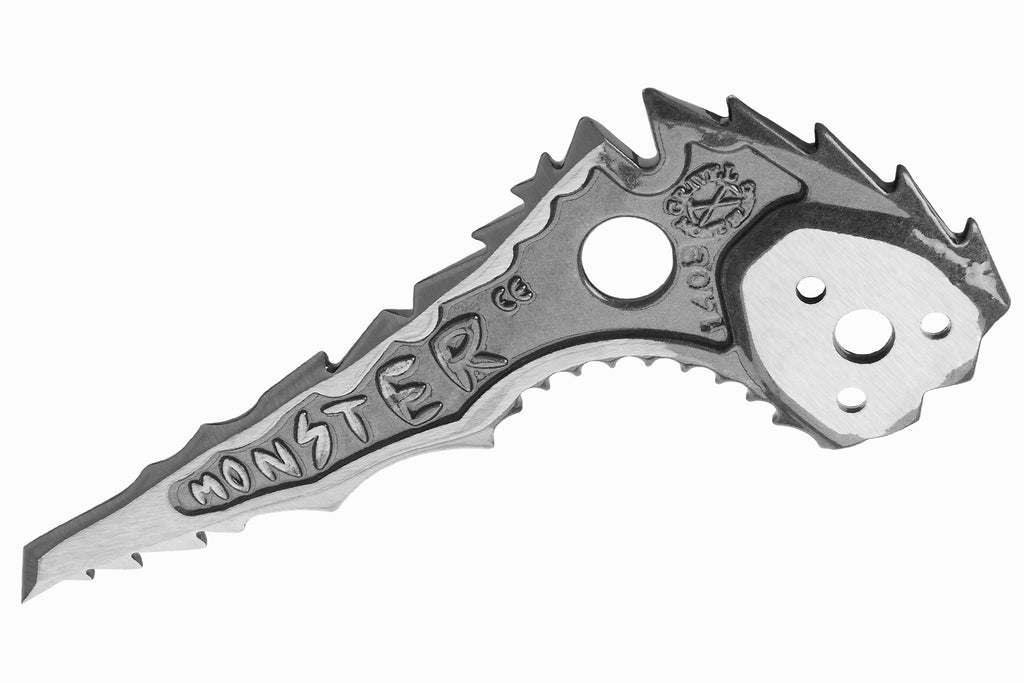
Modern and contemporary times.
In the 2000s and beyond, the blades continued the path of specialization, which can be classified into:
1) pure ice blades: the thinnest ones, they are sharpened and have a specific shape and teeth to facilitate penetration into the ice and subsequent extraction. TOTAL ICE VARIO.
2) mountain and mixed blades: robust and multipurpose blades, suitable for use on mountain terrain where ice, rock and every possible combination of the two are found. ICE VARIO e ALPINE VARIO. KATANA ICE VARIO.
3) dry tooling and competition blades: these are robust and thick blades, designed for the typical hooks of dry tooling and competitions. Their hooked shape makes their use on ice problematic. TOTAL DRY VARIO e DRY PLUS.
Technology has a fundamental weight.
The blades were initially obtained from recovering the steel of the old railway tracks, and later they were made with chromium-molybdenum alloys which were shaped by beating and forging to obtain the desired shape, then hardened with an artisan procedure, handed down as an art. If we analyze the evolution of ice climbing, the influence of the technological development of materials has been decisive for the progress of sports performance!
Today the blades are produced with industrialized operations and very high temperatures. Until the 1990s, low alloy nickel-chromium-molybdenum steels were used which were then tempered and found, but sometimes it still happened that some blades broke during use. Since the early 2000s the steels are supplied with very low phosphorus and sulphur, and today breaking a blade is a very rare.
For the blades of technical ice axes, we now use two types of production processes:
Forging: it is a hot plastic deformation of the metal, it allows to obtain very elaborate and three-dimensional shapes, it allows to vary the thicknesses on the same piece and substantially put the right amount of material in each section of the blade, lightening where it is subject to less load.

CNC shaping: starting from the highest quality material, the desired shape is extracted.

Since there is no deformation of the material during the production phases, it is possible to use materials with superior mechanical characteristics, i.e. micro-alloyed steels, obtaining thinner and more uniform blades along the entire section. The greatest value lies in the quality of the steel grain which is super-refined to guarantee the total absence of defects, systematically checked by ultrasound checks. TOTAL ICE VARIO e TOTAL DRY VARIO e DRY PLUS e IICE BLADE e ICE PLUS BLADE
Katana blades.
The latest generation of Grivel blades is called KATANA, like the ancient Japanese swords with which they share some characteristics.
Japanese swords were produced starting from two steel plates, one with a high carbon content, the other in mild steel. The two plates were heated and joined by beating, they were then folded to obtain 4 layers, folded again to obtain 8 layers up to 15 successive folds, with which thousands of alternating steel layers are obtained. The alternation of the very thin layers balanced the characteristics of hardness (hard layers) and flexibility of the sword (mild steel layers).

Similarly, the steel of the Katana Grivel beaks is composed of a matrix where the alloy elements are micro-diffused, simulating, but in a more effective and repeatable way, the alternation of the layers of the ancient swords.
The result is a series of reliable and durable tips, paving the way for a new generation of tools and accessories available.
This is the logical choice for those who want a series of very performing blades, for very technical climbs or a demanding expedition, where re-sharpening on the wall can be complicated, or for those who simply want to play with the most advanced blades available today on the market.
High mechanical characteristics allow to reduce the thicknesses and keep low sections, lightened blades, weight moved forward, they are the ultimate weapon for the technical mixed climbing.
Katana series products: Katana Ice Vario, Katana G20 plus points, Katana G22 plus points.







